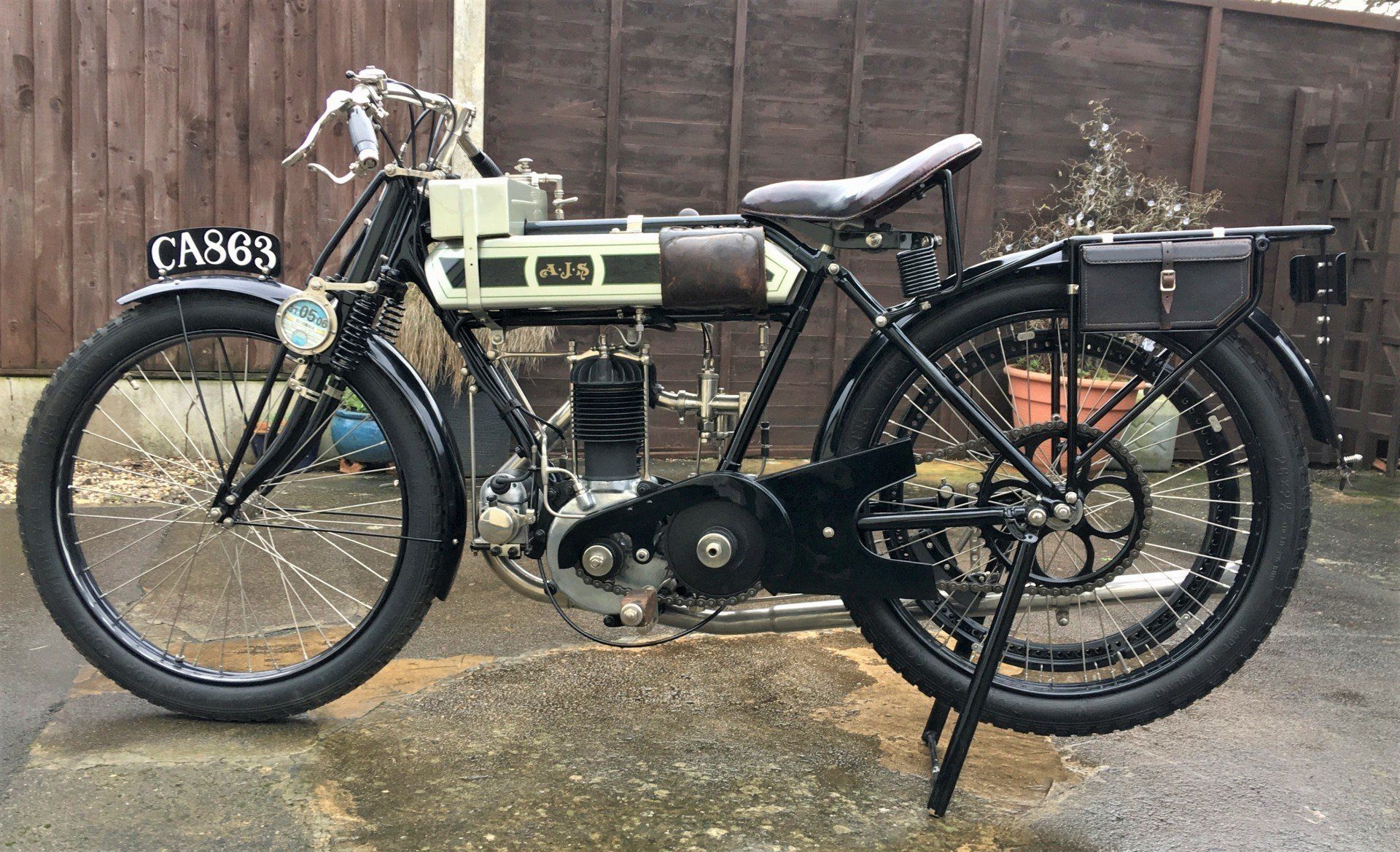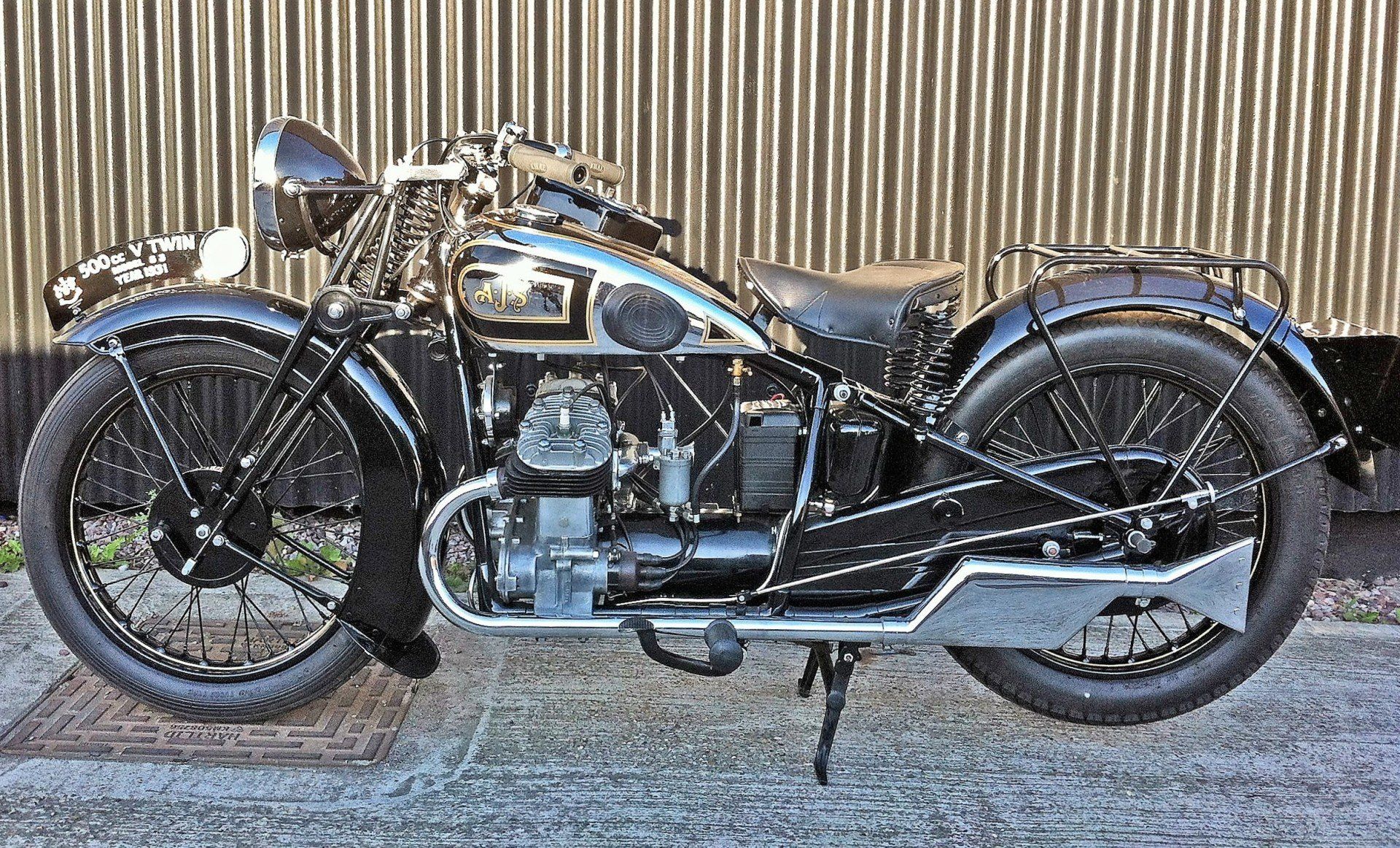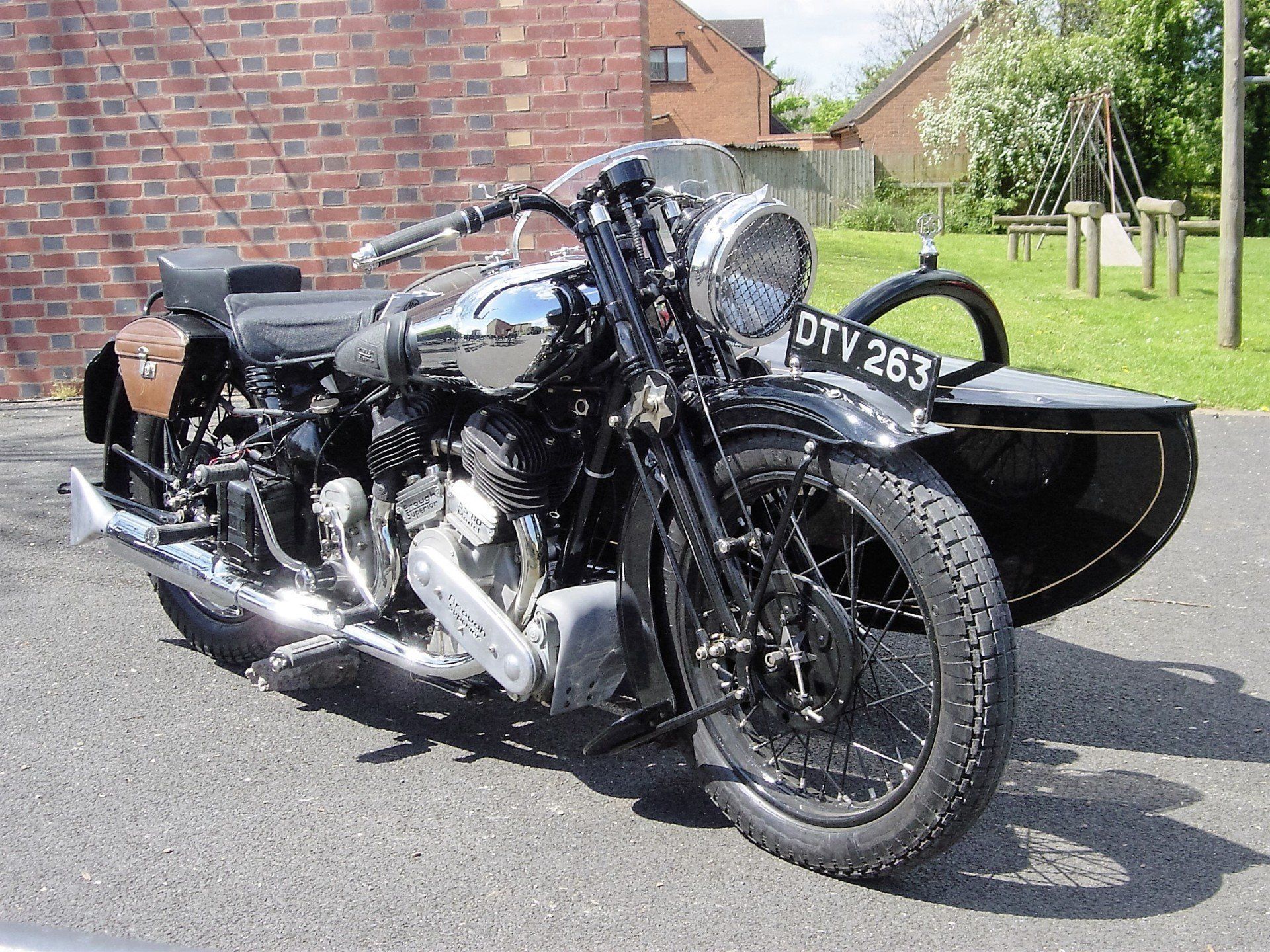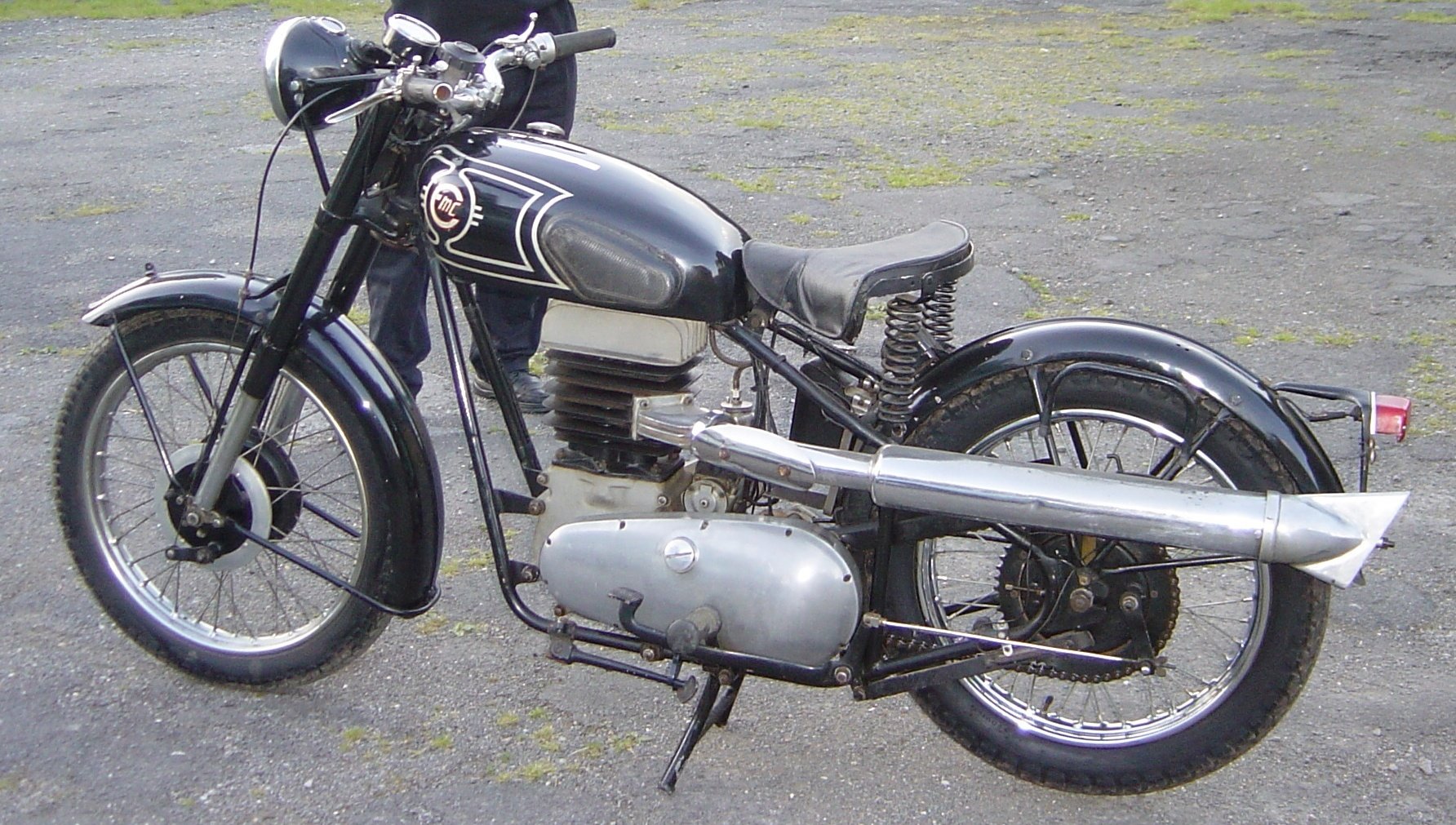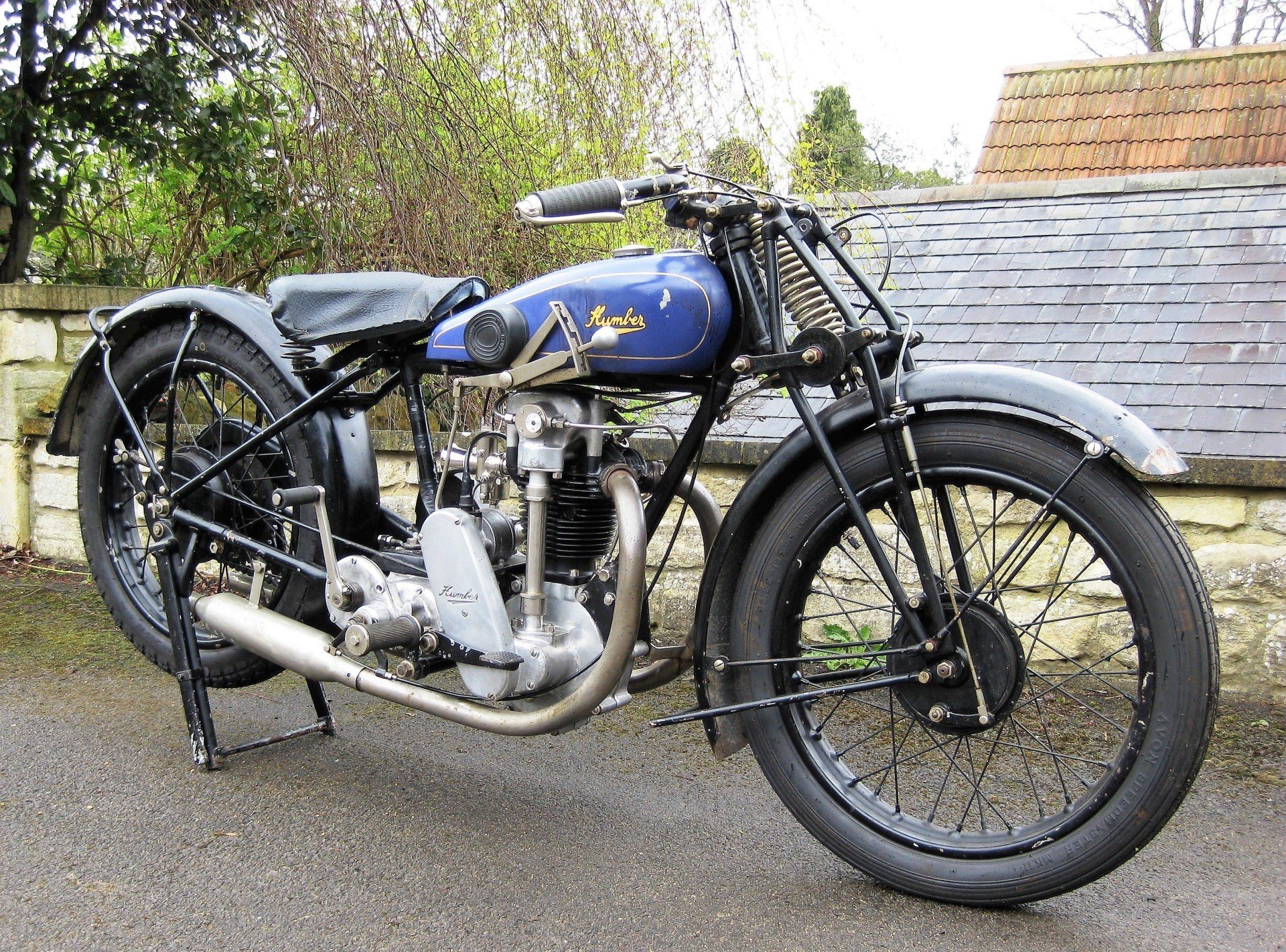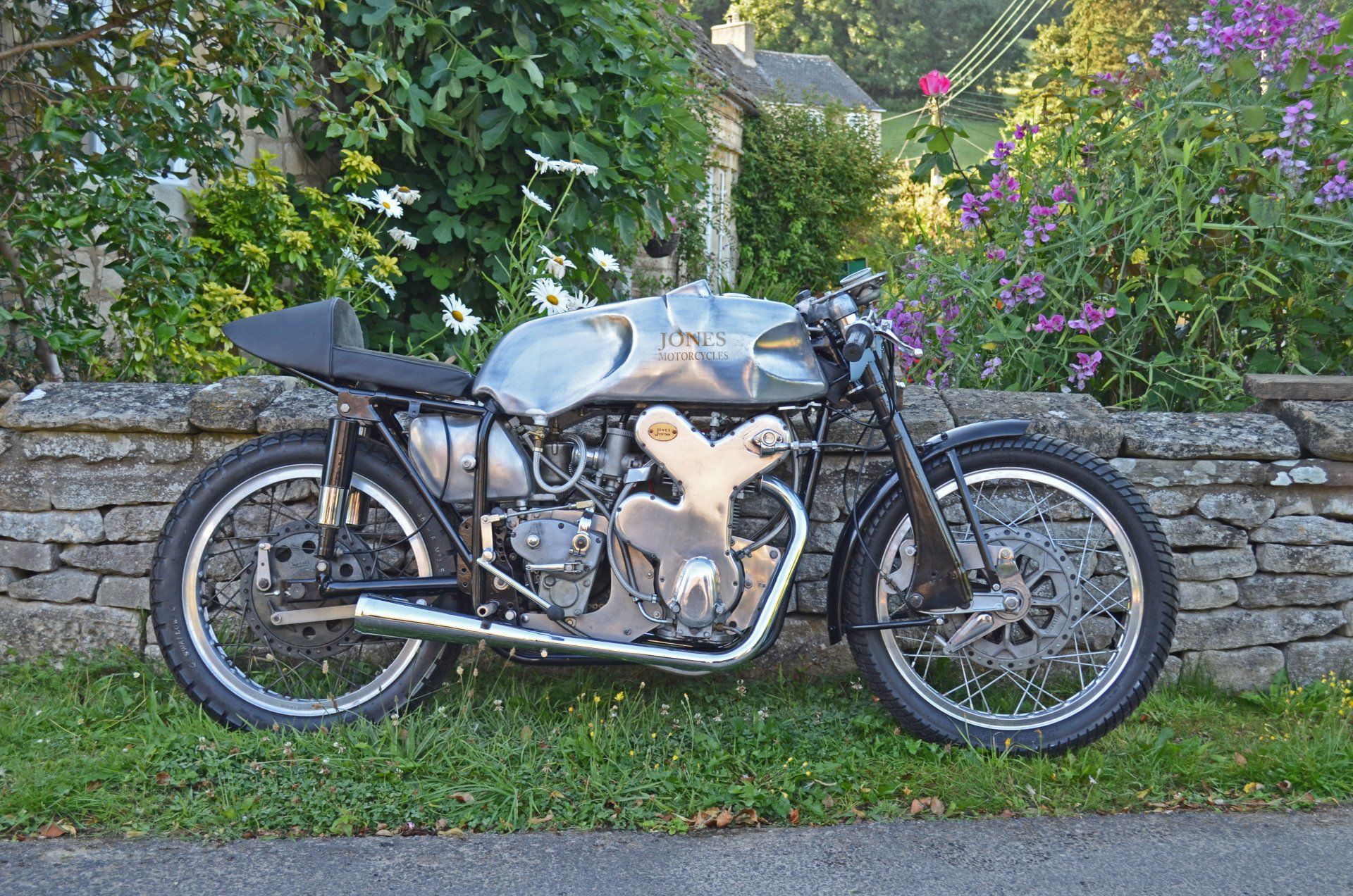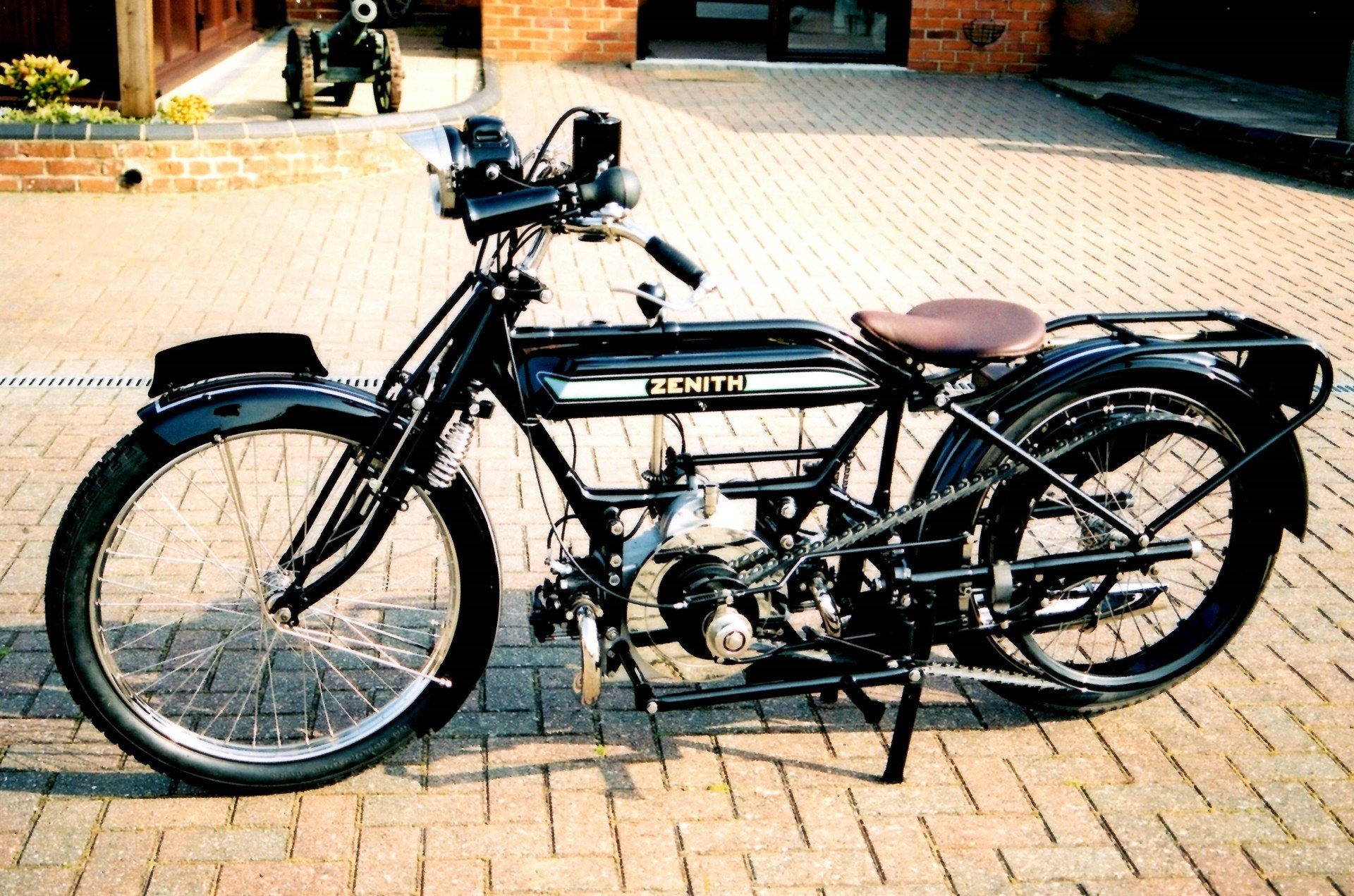The Collection
The Collection
In this section you’ll find photos and descriptions of many of the machines owned by the BMCT.
1913 AJS 350 TT Model
Made by A J Stevens Ltd
Wolverhampton
This is the semi-works 350cc AJS that finished fourth in the 1914 Junior TT at 43.1 mph, ridden by Billy Jones. Although a private entry (through his company, North Wales Motor Exchange), Jones received significant support from the AJS works team, including a works-spec. engine and a “saddle” oil tank that allowed extra room for fuel in the main petrol tank.
AJS machines finished the five-lap race first (Eric Williams), second (Cyril Williams, no relation), fourth (Billy Jones), sixth (Bert Haddock) and 29th (Billy Heaton). Heaton had been lying in second place but crashed coming over the mountain for the final time, remounting and limping his machine home with a buckled front wheel. Third place was awarded to F. J. Walker on a Royal Enfield, although he had crashed with fatal consequences after crossing the finish line some 56 seconds ahead of Billy Jones.
The Jones TT bike remained in Wrexham for several years. Billy had it as a showpiece in his shop before selling it to a local man (also called Jones) who kept it until the 1950s. It had deteriorated somewhat by the time another Wrexham man, Eric Stevens, discovered and restored it in time to take it back to the Isle of Man for a parade lap of the course in 1959. Graham Walker persuaded Eric to loan the bike to the Montagu Motor Museum where it stayed until being acquired by John Griffith, who displayed it at his Stanford Hall Motorcycle Museum.
The last owner of the AJS was Ray Carter, who owned and cherished the bike since 1983. Ray used it on VMCC club runs several times before the woeful lack of braking power persuaded him to take it off the road a dozen or so years ago. It was no slouch on the road, apparently. Eric Stevens had it timed at over 70 mph over a flying half-mile after he’d rebuilt it!
This unique, sole surviving AJS from the 1914 Junior TT will now return to its spiritual home on the Isle of Man where it will be one of the stars of an impressive new TT and Manx Grand Prix gallery opening later this year at the Manx Museum in Douglas.
1931 AJS S3 500cc v-twin
Made by: A J Stevens (1914) Limited,
Wolverhampton
An innovative transverse v-twin with chain final drive, the S3 was one of the last designs from AJS before the company went in to liquidation and was bought by Matchless Motorcycles. Very few of this model were made and they are now extremely rare. This one was a basket case in an Austrian collection before being acquired and restored by the BMCT. It can be seen at the Black Country Living Museum in Dudley.
1917 Alldays Matchless 2.75hp two-stroke
Made by Alldays & Onions
Sparkbrook, Birmingham
One of the UK’s longest established engineering companies, Alldays could trace their origins back to 1650. They began to produce motorcycles in 1903, initially powered by their own engine, and latterly by proprietary motors such as the Wolverhampton-made Villiers in the bike shown here. Another machine acquired by us in a terrible state after many years storage, it has been restored by the Sammy Miller Museum, where it is now exhibited.
1922 Banshee 269cc two-stroke
Made by Banshee Mfg. Co.
Bromsgrove
Banshee were fairly typical of the smaller manufacturers who sprang up in the post-WW1 years to satisfy the demand for personal transport. They assembled their machines using mainly bought-in components, engines from Villiers and Barr & Stroud, gearboxes from Albion, and so on. This Villiers-engined bike is another rusty wreck we entrusted to Sammy Miller for restoration, and it can been seen on display in his Museum.
1929 Baughan 500cc ohv Trials Combination
Made by Baughan Motors, Stroud
Henry Baughan established his engineering business in Harrow, moving to Stroud when he branched out into motorcycle and cyclecar manufacture in the early 1920s. He was a keen trials rider, and developed this two wheel drive sidecar outfit which came to dominate competitions in the period. A Blackburne engine was employed, and motorcycle production continued until war work took over as the factory’s main activity. This machine is the actual works bike, ridden to so many successes by Bill Hayward. Baughans later played a big part helping Frank Whittle’s development of the jet engine.
1925 Beardmore Precision 500cc sv
Made by F E Baker Ltd
Kings Norton, Birmingham
Frank Baker’s company became associated with the giant William Beardmore engineering group in 1920, allowing his unconventional designs to reach a larger audience than previously. The cycle parts were a mixture of pressed steel and tubes, with the petrol tank forming the top frame member. Suspension was unusual, too, being controlled by front and rear leaf springs. Made with various engine options, our example has the rarer 500cc Precision motor, and is on long term loan to the Grampian Transport Museum.
1937 Brough Superior SS80 v-twin sv
Made by George Brough
Nottingham
George Brough left the motorcycle maker owned by his father in 1919 to make bikes of his own design, rather cheekily called Brough Superior to distinguish them from his father’s products. Dubbed the Rolls-Royce of motorcycles, his machines were very special, using only the very best bought-in components for the cycle parts and powerful JAP and Matchless engines Production ceased in 1939, and Brough Superiors are now amongst the most valuable motorcycles in the world. Our Matchless powered bike has a Brough sidecar and is kept at the Haynes Motor Museum.
1911 BSA 3.5hp sv
Made by BSA Cycles Ltd
Small Heath, Birmingham
Britain’s largest motorcycle manufacturer had their origins in the gun trade, but in 1880 branched out into bicycles, and made their first complete motorcycles in 1910. The bike seen here owned by the BMCT is one of the earliest examples, and when new sold for £50. It is preserved in remarkably original condition, and can be seen at the Grampian Transport Museum.
1923 Carfield Baby 147cc two-stroke
Made by Carfield Motor Co. Ltd.
Smethwick
Carfield were another of the motorcycle firms that sprang up to meet the demand for personal transport that grew after WW1. Founded in 1919 they produced machines powered by Villiers, Coventry Victor and JAP, and in 1923 launched the ‘Baby’, a lightweight Villiers engined bike that sold for just £29. Despite the low price they were tough little things, with one rider achieving a Bronze medal in the Scottish Six Days Trial. Carfield folded in 1928, and our ‘Baby’ is displayed at the Black Country Museum in Dudley.
1914 Coventry Challenge 269cc two-stroke
Made by Challenge Cycle Co.
Coventry
Coventry Challenge were constructed from 1903 by a cycle manufacturer who fitted various engines into his heavy duty bicycle frames and completed them with bought in parts, including engines from Minerva and Fafnir, and later JAP and Precision. In 1914 they produced this model, with a Villiers engine of 269cc.
This bike was left in a barn in 1923 and lay there until it was discovered by an enthusiast in 1996. It’s now fully restored and on show at Coventry Transport Museum.
1963 Cotton Telstar 250cc two-stroke
Made by Cotton Motorcycles Ltd.
Gloucester
Cotton were involved in motorcycle manufacturing from 1913 to 1980, with interruptions. Founder F.W. (Bill) Cotton patented the triangulated frame that formed the basis of his company’s early production. After WW2, production restarted in 1953 with an emphasis on sporting machines. The Villiers Starmaker engined Telstar was a pace setter in quarter litre racing in the early ’sixties, and our bike is the only one left in original specification. You can see it at the Folk of Gloucester museum, just yards from the site of the old Cotton factory near the centre of Gloucester.
1920 Diamond 269cc two-stroke
Made by Diamond Cycle Co.
Wolverhampton
The firm’s first motorcycles were offered in 1908, powered by Belgian FN engines. After WWI they moved to Vane Street and turned out a number of lightweights with Villiers and JAP engines. In the twenties Diamond were owned by Sunbeam and entered the TT for many years but failed to register any major successes. In 1933 motorcycle production ceased and the company concentrated on making trailers and milk floats along with frames for other motorcycle factories. This bike can be seen at the Black Country Living Museum in Dudley.
1947 EMC Mk 1 350cc two-stroke
Made by Ehrlich Motor Co.
London
Josef Ehrlich was an Austrian who fled the Nazis in 1937 and settled in England. He brought with him the designs for a split single two stroke motorcycle engine, based on a Puch design, and in 1947 set up a factory in Park Royal north-west London to produce the EMC motorcycle using this engine. The first models had 350cc engines housed in an up-to-date duplex cradle frame with Dowty Oleomatic front forks and Vincent double-sided front brakes. This interesting machine is located at the Internal Fire Museum of Power in West Wales.
1922 Hazlewood 678cc V-twin sv
Made by Hazlewoods Ltd.
Coventry
The Hazlewood was built in West Orchard, Coventry by a firm established in 1876. The first machine used a JAP 2.75hp engine and had belt drive to a three-speed Armstrong hub. By 1913 they had developed a twin, powered by a 3.5 or 5hp JAP, the larger model featuring a chain-cum-belt transmission. The vast majority of Hazlewood production was exported to the Colonies, which explains why they are rather rare in the UK. Motorcycle production ended in 1924. This combination is on display at Coventry Transport Museum.
1904 Humber Forecar 4.5hp sv
Made by Humber & Co.
Coventry
From 1902 Humber began manufacturing a range of motorcycles and forecars using a single cylinder P&M engine with a two speed chain drive transmission. A 340cc two speed V twin Humber won the 1911 Junior TT and other variants followed, but the company quit motorcycles in 1930 to concentrate on cars. This Forecar is one of the oldest machines in the BMCT Collection, and can be seen at Coventry Transport Museum.
1921 Humber 4.5hp flat twin sv
Made by Humber & Co.
Coventry
This was Humber’s first peacetime offering after WWI and was based on a pre-war design. The engine had markedly over square dimensions of 75x68mm, unusual at the time, giving a capacity of 601cc, and drove through an advanced all-chain transmission via a three-speed gearbox. The machine was renowned for its smooth and quiet running, becoming known as the ‘Silent Humber’ and was thought of in motorcycling circles as ‘Coventry’s finest production’ . On show at Coventry Transport Museum.
1928 Humber OCS 350cc ohc
Made by Humber & Co.
Coventry
From 1923 onwards the Humber factory was busy developing a new range of motor cars, and their motorcycle range consisted mainly of 350cc singles of various types. There were sv, ohv and ohc variants, but production of the bikes ceased in 1930 to allow the company to concentrate on cars. The 350cc ohc Sports model seen here was Humber’s attempt to challenge the ‘cammy’ Velocette range of the time. Repatriated from Australia and on display at the Grampian Transport Museum.
1949 Jones 250cc ohc twin
Made by Dennis Jones
Derby
Made in his spare time by Dennis Jones, a Derby-based Rolls-Royce engineer and racing motorcyclist who, frustrated by the lack of availability of a competitive British racing 250 in the late 1940s, built his own. The double overhead camshaft four stroke twin and Albion gearbox is fitted into a frame of Dennis’s own design. The machine is currently at the Sammy Miller Museum, but will be going to the new Derby Museum in 2021.
1904 Kerry 3.5hp sv
Made by East London Rubber Co.
London
Marketed from 1902 to 1914. A variety of proprietary engines were used, including Belgian FN and Kelcom. The loop frame design was used to circumvent the Werner patent which applied to machines using the crankcase as part of the frame. In 1910 Kerry moved production to Abingdon, and production finished with the outbreak of WWI. This Pioneer motorcycle is part of the BMCT display at Grampian Transport Museum.
The British Scooter Collection
In 2013 the BMCT acquired a collection of British motor scooters from Robin Spalding of Surrey. In assembling his collection, Robin’s aim was to have an example of every make of scooter produced in Britain between 1946 and 1970, and by the time he had achieved this, his collection consisted of over 40 machines. Having completed the task, and written a book about it, with the help of the BMCT Robin put the British Scooter Collection on display at Coventry Transport Museum for a six-month period and was intending to dispose of it when the exhibition ended. The BMCT stepped in to purchase the collection to ensure it was kept together and arranged for it to be housed in a new hall at the Haynes International Motor Museum from 2016 to 2020. That exhibition has now closed and the scooters are in storage while we arrange their transfer to another museum.
1918 Lea Francis 3.25hp v-twin sv
Made by Lea & Francis Ltd.
Coventry
Richard Lea and Graham Francis started out as bicycle makers based in Coventry in 1895. They dabbled in cars in the early years of the 20th century before switching to motorcycles in 1912 with a range consisting of just one model, a high quality 3.25hp JAP engined V-twin with enclosed chain drive. George Bernard Shaw was one of Lea-Francis’s better known customers, and they continued motorcycle production until 1924, concentrating thereafter on cars until the nineteen fifties. Can be seen at Grampian Transport Museum.
1920 Martinsyde-Newman 680cc v-twin eoi
Made by Martinsyde Ltd.
Brooklands
Martinsyde turned to motorcycle production in 1919 when demand for its aircraft tailed off in the aftermath of World War I. They enlisted the help of Howard Newman, who brought with him the designs for a machine powered by a 680cc exhaust-over-inlet V-twin driving through a three speed AJS gearbox. Production hardly had time to get established before a disastrous fire ripped through the factory, sending Martinsyde into liquidation. The motorcycle is currently exhibited at the Brooklands Museum in Surrey.
1917 Matchless 8B/2M 976cc v-twin sv
Made by H. Collier & Sons Ltd
London
The Imperial Russian Government placed an order with Matchless for 250 of these JAP-engined machines, but the October Revolution of 1917 led to cancellation of the order, and the completed batch was released for use by the British Army in the latter stages of World War 1. This outfit was sold off by the War Department in 1919, and was derelict when discovered in 1996. It was restored to its full military specification, including the correct Vickers water cooled machine gun, and placed on display at the Tank Museum in Dorset.
1923 New Hudson 4.5hp Combination sv
Made by New Hudson Cycle Co.
Birmingham
After six years as a bicycle manufacturer, New Hudson began to make motorcycles in 1909 at their Birmingham factory. Production was interrupted by the war, but by the early twenties their range was impressive. Competition success by riders such as Bert Le Vack, Jimmy Guthrie and Tommy Bullus followed, but in the early thirties the firm was swallowed up by BSA. Part of the new motorcycle display at the Haynes International Motor Museum.
1958 Norman B2S Roadster 197 cc two-stroke
Made by Norman Cycles Ltd.
Ashford
Norman motorcycles were built in Ashford, Kent, on the site of what is now a Eurostar train station. Norman started as enamellers and platers, turning their hand to bicycles in the mid-1930s, and producing their first powered two-wheelers in 1938. The B2S was introduced in 1952 and featured Armstrong leading-link forks and Villiers engines. The B2S was built in Roadster and Sports versions from 1959 and continued in the range until production ceased in 1961. This fully restored B2S Roadster can now be seen in the replica Norman dealership at the Dover Transport Museum.
1960 Norman B3 Sports 250cc two-stroke
Made by Norman Cycles Ltd.
Ashford
Another product of Norman’s Ashford factory was the B3 Sports, powered by the larger 250 cc Villiers 2T twin-cylinder engine. These were quite good performers, so good in fact that one of them finished second in class in the prestigious Thruxton 500-Mile race for production motorcycles, beaten only by a 250 overhead camshaft NSU Max. This is another example of the Norman marque that can be found in Dover Transport Museum.
1960 Norman B4 Sports 250cc two-stroke
Made by Norman Cycles Ltd.
Ashford
Joining the Norman line-up at the 1960 Motorcycle Show was the B4 Sports, unashamedly aimed at the younger rider with its Italianate styling and twin cylinder engine, and boasting a top speed of over 75 mph. The model was to be the Ashford factory’s swansong, however, as the firm was sold to Raleigh Industries who moved production to the Midlands in 1962. This bike now resides with its stablemates in Dover Transport Museum.
1960 Norton 350cc ohc Manx
Made by Norton Motors Limited
Birmingham
As one of the most successful racing motorcycles ever produced, the Manx Norton needs no introduction. The example you see here was purchased new for the 1960 season by Bill Beevers, and was acquired by amateur racer Ben Noble in 1965. Ben campaigned the bike at the Manx Grand Prix for some thirty years in the Junior and Junior Classic classes, with a best result being 19th in the 1985 Classic, and a best lap speed of 81.86 mph in 1993. Still exactly as last raced , the amazingly original Manx is now appropriately installed in the Manx Museum, Douglas, Isle of Man.
1928 Omega 170cc two-stroke
Made by W J Green Ltd.
Coventry
W J Green set up his own motorcycle company in 1914 after spells with Humber and Premier. After WW1 the range consisted of motorcycles ranging in capacity from 170cc to 490 cc, and a three-wheeled car with a 980 cc JAP engine, but this proved to be too much for the tiny, underfunded company, and they struggled until finally folding in 1928. This, one of the last machines to come out of the factory, is displayed at Coventry Transport Museum.
1921 Revere 2.5hp two-stroke
Made by W H Whitehouse Ltd.
Coventry
Revere lightweight motorcycles were marketed between 1915 and 1922, using frames made by Sparkbrook of Coventry and a 269cc two stroke engine supplied by Villiers of Wolverhampton. Some models were single speed with belt drive, but others featured two-speed gearboxes by Sparkbrook, Sturmey-Archer or Albion. This rare machine was in continuous use until 1932, and since its acquisition by the BMCT has been exhibited at Coventry Transport Museum.
1926 Rex Acme 350cc ohv TT Model
Made by Rex Motor Manufacturing Co.
Coventry
Birmingham maker Rex merged with Acme in 1922 and produced a range of mostly single cylinder models until 1933. Their most famous machines were powered by Blackburne engines, and in 1925 their Works manager Wal Handley won the Junior TT on a machine very similar to the one shown here. Further TT successes followed, as well as the world’s one-hour record set by Handley at 91.21 miles in 1926. On show at Coventry Transport Museum.
1925 Scott 498cc Flying Squirrel two-stroke
Made by Scott Engineering Co.
Shipley
Alfred A Scott was a pioneer of two strokes and produced many innovative designs from his works in Shipley, Yorkshire. Scott himself left the company in 1915 but the name continued to be associated with high performance water cooled models like the Flying Squirrel which produced a heady 24 bhp in 1925! This fully restored bike can be seen at the Internal Fire Museum of Power in West Wales.
1924 Sparkbrook 350cc sv
Made by Sparkbrook Manufacturing Co.
Coventry
Originally a bicycle firm, Sparkbrook entered the powered field in 1912 with a sidecar model using a JAP V-twin rated at 6 hp. The war years interrupted production, but the name returned in 1919 with a small range using the 269cc Villiers two-stroke engine. More models followed from 1922 featuring JAP, Villiers and Barr & Stroud power. Production ceased in 1924, and this JAP-engined example was one of the last to leave the factory. It’s on display at Coventry Transport Museum.
1930 Sunbeam 350cc ohv Model 10
Made by John Marston Ltd.
Wolverhampton
Sunbeam had built up a reputation for robust, well engineered and beautifully finished motorcycles, and in 1930 the newcomer Model 10 was built to carry on this tradition. Among the many interesting features of the new model was the lubrication system, which was dry sump but with the oil tank contained within the crank case. Another unusual piece of design was the locating of the pivot of the hand-change gear lever directly on the rocker box. This gave a convenient position for the lever near the rider’s right knee. Currently at the Black Country Living Museum.
1939 Sunbeam B24S 350cc ohv
Made by Associated Motor Cycles Ltd
Plumstead, London
Originally founded in Wolverhampton, Sunbeam were taken over by ICI in 1928, and when they lost interest in motorcycles in 1937 the firm became part of Associated Motorcycles, formed in 1931 when Matchless purchased AJS, another famous Wolverhampton make. This very rare 1939 B24 Sports is one of only two known road worthy survivors of the model, and is displayed at the Grampian Transport Museum.
1971 Triumph Bandit 350cc ohc twin
Made by Triumph Engineering Co.
Meriden
Developed to compete with Japanese offerings in the sporting middleweight class, the Triumph Bandit (and its sister BSA Fury) were hugely advanced compared with other British bikes of the time. Overhead camshaft, electric start, all-welded frame, five speed gearbox were all part of the specification, but sadly it was a case of too little, too late. The BSA/Triumph Group were already in dire trouble, and lack of funds forced cancellation of the project after only a few prototypes had been built. This one is in the Grampian Transport Museum.
1936 Triumph Tiger 80 350cc ohv
Made by Triumph Engineering Co.
Coventry
Edward Turner’s first job when he arrived at Triumph in 1936 was a makeover of the designs he had inherited from Val Page. He took the staid looking model 3/2 and waved his magic wand over it, splashing chrome and bright coloured paint where there had been dull black, and came up with the evocative Tiger 80 name. The bikes from the first few moths of Tiger production still featured the twin down-tube frame and are extremely rare. This one is on show at Coventry Transport Museum.
1920 Whippet 150cc ohv
Made by W G C Hayward Ltd.
Twickenham
This early motor scooter featured a neat 150cc ohv power unit and a frame made of multiple tubes supporting a foot platform, single saddle above the engine, and a cylindrical fuel tank at the rear. There was even a sports version with a racing saddle and wide handlebars. ‘Runs like a big six’ was one of the advertising slogans used by Haywards at the time! This example was restored to as new condition by Sammy Miller, and now features in his museum.
1914 Wolf 292cc sv
Made by Wearwell Cycle Co.
Wolverhampton
Originating in the Black Country, Wolf is closely linked with Wulfruna, Wearwell and Stevens (later AJS). The Clarke brothers of Darlington Street Wolverhampton established the Wearwell Cycle Company in 1889 and produced their first powered two-wheeler at the turn of the century. In 1901 the Wearwell-Stevens appeared, and the name ‘Wolf’ was first used on one of their motorcycles in 1905. This JAP- engined Wolf was discovered under a pile of scrap and rubble in Buckinghamshire in 1955 and restored to running order in 1959. It can be seen at the Black Country Living Museum in Dudley.
1955 Wooler 500cc ohv flat four
Made by Wooler Engineering Co.
Wembley
John Wooler made his first motorcycle in 1911, and his designs owed more to his love of innovation than to any commercial considerations. Those of his designs that made it past the prototype stage were usually produced under licence by firms like Wilkinson Sword and P&P. This, the last model Wooler designed, featured a flat four engine, interchangeable wheels, no top yoke for the forks, and a toolbox integrated into the aluminium gearbox casing. Wooler boasted that the bike could be maintained using just one spanner and a screwdriver! Only a handful of prototypes were made, this one being the actual 1954 Earls Court Show bike. Restored by Sammy Miller, it’s on show at his New Forest museum.
1921 Zenith Bradshaw 3.5hp flat twin
Made by Zenith Motor Engineering
London
Zenith began in 1904 in Finsbury Park, London with the extraordinary Freddy Barnes designed Bi-Car. In 1907 they introduced the Gradua Gear system combining a variable engine pulley with movement of the rear wheel to maintain correct tension of the drive belt, which other competitors claimed was unfair, and many clubs banned the Gradua Zeniths. The Bradshaw horizontally opposed overhead valve engine in this machine is noteworthy for its advanced oil-cooling system. The bike can be seen on display at the Sammy Miller Motorcycle Museum.
Copyright©British Motorcycle Charitable Trust 2023. All rights Reserved
Privacy Policy and website Terms and Conditions
Privacy Policy and website Terms and Conditions
The British Motorcycle Charitable Trust. Charitable Incorporated Organisation,
Office : Holly Cottage, Main Street, Bishampton, Pershore, Worcestershire, WR10 2NH

